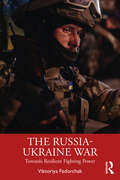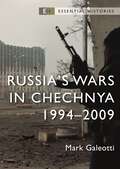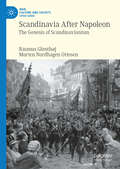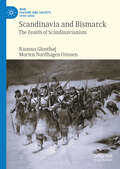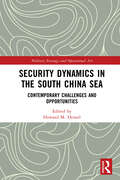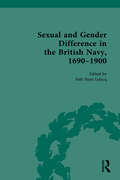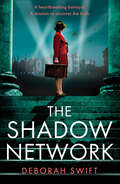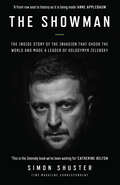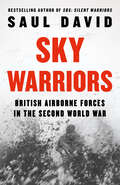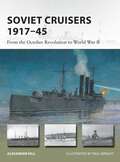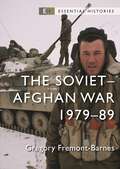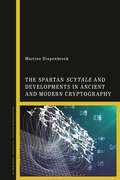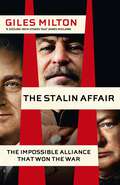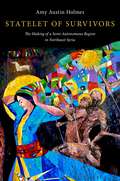- Table View
- List View
Royal Navy Home Fleet 1939–41: The last line of defence at Scapa Flow (Fleet #5)
by Angus KonstamPacked with illustrations, this is a new history and analysis of how the Royal Navy's most important fleet operated and fought the German Navy in the crucial first years of World War II.Throughout its history, the Royal Navy's most powerful fleet has been the one guarding home waters. In this book, naval historian Angus Konstam explores the fighting power, the roles, and the battles of the Home Fleet, in the crucial first years of World War II when it was Britain's most powerful fighting force, anchored in the northern bastion of Scapa Flow. He explains the complex responsibilities of the fleet, charged simultaneously with preventing the powerful German Navy from breaking out into the Atlantic; preparing to challenge any cross-Channel invasion force; and attacking German naval operations in the North Sea. Home Fleet actions included the loss of HMS Hood, the sinking of the Bismarck and countering the invasion of Norway, Germany's biggest amphibious operation of the war.Packed with striking new artwork and 3D diagrams and maps, this book offers a detailed portrait of the Home Fleet during these most crucial years of the war, from the capabilities of the warships to logistics and intelligence-gathering, to how the fleet was organized and commanded, and how and why it fought as it did.
The Russia-Ukraine War: Towards Resilient Fighting Power (Routledge Advances in Defence Studies)
by Viktoriya FedorchakThis book provides a systematic analysis of the Russian-Ukraine war, using the concept of resilient fighting power to assess the operational performance of both sides during the first year of the full-scale invasion.The Russian war in Ukraine began in 2014 and continued for eight years, before the full-scale invasion of 24 February 2022. It is not a new war, but the intensity of the warfighting revived many discussions about the conduct of inter-state warfare, which has not been seen in Europe for decades. This book does not aim to offer an exhaustive operational analysis of the war, but rather provides a preliminary systematic analysis across various domains of warfare using the concept of fighting power to assess the operational performance of both sides. First, the book discusses the conceptual component and the post-Cold War adaptations of the Soviet strategic tradition by both the Ukrainian and the Russian Armed Forces. Following that, it gives an evaluation of the various aspects of warfighting in the land, air, maritime and cyber domains. Then, the book examines the role of international allied assistance, sanctions and weapons delivery in strengthening the resilience of the Ukrainian Armed Forces. The book concludes with some comments on the role of inter-state warfare in the current strategic environment and future warfare.This book will be of much interest to students of military and strategic studies, defence studies, foreign policy, Russian studies and international relations.
The Russia-Ukraine War: Towards Resilient Fighting Power (Routledge Advances in Defence Studies)
by Viktoriya FedorchakThis book provides a systematic analysis of the Russian-Ukraine war, using the concept of resilient fighting power to assess the operational performance of both sides during the first year of the full-scale invasion.The Russian war in Ukraine began in 2014 and continued for eight years, before the full-scale invasion of 24 February 2022. It is not a new war, but the intensity of the warfighting revived many discussions about the conduct of inter-state warfare, which has not been seen in Europe for decades. This book does not aim to offer an exhaustive operational analysis of the war, but rather provides a preliminary systematic analysis across various domains of warfare using the concept of fighting power to assess the operational performance of both sides. First, the book discusses the conceptual component and the post-Cold War adaptations of the Soviet strategic tradition by both the Ukrainian and the Russian Armed Forces. Following that, it gives an evaluation of the various aspects of warfighting in the land, air, maritime and cyber domains. Then, the book examines the role of international allied assistance, sanctions and weapons delivery in strengthening the resilience of the Ukrainian Armed Forces. The book concludes with some comments on the role of inter-state warfare in the current strategic environment and future warfare.This book will be of much interest to students of military and strategic studies, defence studies, foreign policy, Russian studies and international relations.
Russia’s Wars in Chechnya: 1994–2009 (Essential Histories #78)
by Mark GaleottiWritten by a leading expert on modern Russia, this is an illustrated introduction to the bitter campaigns in Chechnya.In this new edition of his popular 2014 work, Mark Galeotti traces the progress of the wars in Chechnya, from the initial Russian advance through to urban battles such as Grozny, and the prolonged guerrilla warfare in the mountainous regions. Bringing the book up to date, including a revised introduction and new content on the Kadyrovtsy's role in Russia's other conflicts, Galeotti assesses how the wars have torn apart the fabric of Chechen society and their impact on Russia itself.Featuring full-colour maps and 50 new images, and drawing upon a wide range of sources, this succinct account explains the origins, history and consequences of Russia's wars in Chechnya, shedding new light on the history – and prospects – of the troubled region.
Scandinavia After Napoleon: The Genesis of Scandinavianism (War, Culture and Society, 1750–1850)
by Rasmus Glenthøj Morten Nordhagen OttosenThis book explores the intellectual grounds of Scandinavianist ideology and its political development into a national unification movement. Denmark, Norway and Sweden were nearly annihilated during the Napoleonic Wars. The lesson learned was that survival was a matter of size. Whereas their union of 1814 offered Sweden-Norway geostrategic security tempered by fear of Russia, Denmark was the biggest territorial loser of the Napoleonic Wars and faced separatism connected to German nationalism in the duchies of Schleswig and Holstein. This evolved into a national conflict that threatened Denmark’s survival as a nation. Meanwhile, a new generation of Danes, Swedes and Norwegians had come to regard kindred language, culture and religion as a case for Scandinavian union that could offer protection against Russia and Germany. When the European revolutions of 1848 unleashed the First Schleswig War, the influence of Scandinavianism was such that it nearly turned into a Scandinavian war of unification.
Scandinavia and Bismarck: The Zenith of Scandinavianism (War, Culture and Society, 1750–1850)
by Rasmus Glenthøj Morten Nordhagen OttosenThis book accounts for Scandinavian unification efforts in a time of great upheaval. The ideological repercussions of the European revolutions of 1848-1849 and the Crimean War (1853-1856) transformed both the international political system and nationalism into more ‘realist’ types. The First Schleswig War (1848-1851) having nearly turned into one of Scandinavian unification, the influence of Scandinavianism extended into the Danish, Swedish and Norwegian courts, cabinets and parliaments, attracting interest from the great powers. The Crimean War offered another window of opportunity for Scandinavian unification, before the Danish-German conflict over the duchies of Schleswig and Holstein nearly united Scandinavia upon the outbreak of the Second Schleswig War in 1864. The ultimate failure of Scandinavianism in its unification efforts was not predetermined, although historiography has made it appear as such. Napoleon III, Cavour and Bismarck all actively contributed to plans for Scandinavian unification, the latter even declaring himself as “very strongly Scandinavian”.
Second Punic War in Iberia 220–206 BC: From Hannibal at the Tagus to the Battle of Ilipa (Campaign #400)
by Mir BahmanyarThe first dedicated, illustrated study of the events of the Second Punic War in Iberia, which served as a launch pad for the Carthaginian invasion of Rome.Iberia was one of three crucial theatres of the Second Punic War between Carthage and Rome. Hannibal of Carthage's siege of Saguntum in 219 BC triggered a conflict that led to immense human and material losses on both sides, pitting his brother Hasdrubal against the Republican Roman armies seeking to gain control of the peninsula. Then, in 208 BC, the famous Roman general Scipio Africanus defeated Hasdrubal at Baecula, forcing Hasdrubal's army out of Iberia and on to its eventual annihilation at the Metaurus. In this work, military historian Mir Bahmanyar brings to life the key personalities and events of this important theatre of the war, and explains why the Roman victory at Baecula led to a strategic shift and Carthage's eventual defeat. It covers Scipio Africanus' brilliant victory at Ilipa in 206 BC, where he crushed the army of Mago Barca and Hasdrubal Gisco. Illustrated with maps, tactical diagrams, battlescene artworks and photographs, this work provides a gripping narrative of the large-scale battles fought in Iberia.
Secrets for the Three Sisters (Three Sisters #2)
by Annie GrovesThe heartwarming new novel from the author of The District Nurses of Victory Walk.
Security Dynamics in the South China Sea: Contemporary Challenges and Opportunities (Military Strategy and Operational Art)
This volume examines the South China Sea’s regional security dynamics, highlighting the challenges and opportunities for both littoral and non-littoral states.The South China Sea is a vital pathway for the great container ships and tankers, as well as for the naval vessels of today. Indeed, the security of the contemporary global economy is reliant more than ever upon the dependability of freedom of navigation through the waters of the South China Sea. This volume concentrates on the security of the South China Sea sub-region. It is designed to help illuminate the contemporary security dynamics within this important sub-region by highlighting its development, the contemporary challenges and opportunities confronting both the littoral states and the non-littoral powers that are active in the sub-region, and the policy responses of those states as they seek to defend and promote their national interests. This book is composed of 16 chapters and is organized into five thematic sections. Part I of the book is designed to set the historical context. Part II examines some of the contemporary challenges and opportunities that present themselves in the sub-region, while Part III focuses on Chinese policy in the South China Sea sub-region. Parts IV and Part V analyse and evaluate the contemporary policies of the various littoral and non-littoral powers that are active in the South China Sea sub-region. The collective analyses and assessments of the contemporary perceptions and policies of the various littoral and non-littoral powers active in the South China Sea in response to the traditional and non-traditional challenges within the sub-region that are examined in the chapters contained in Parts III, IV, and V, framed against the material presented in Parts I and II, provides the basis for observations concerning areas of conflicting and coinciding interests in the concluding chapter of the book.This book will be of interest to students of the South China Sea, maritime security, Asian politics, and international relations.
Security Dynamics in the South China Sea: Contemporary Challenges and Opportunities (Military Strategy and Operational Art)
by Howard M. HenselThis volume examines the South China Sea’s regional security dynamics, highlighting the challenges and opportunities for both littoral and non-littoral states.The South China Sea is a vital pathway for the great container ships and tankers, as well as for the naval vessels of today. Indeed, the security of the contemporary global economy is reliant more than ever upon the dependability of freedom of navigation through the waters of the South China Sea. This volume concentrates on the security of the South China Sea sub-region. It is designed to help illuminate the contemporary security dynamics within this important sub-region by highlighting its development, the contemporary challenges and opportunities confronting both the littoral states and the non-littoral powers that are active in the sub-region, and the policy responses of those states as they seek to defend and promote their national interests. This book is composed of 16 chapters and is organized into five thematic sections. Part I of the book is designed to set the historical context. Part II examines some of the contemporary challenges and opportunities that present themselves in the sub-region, while Part III focuses on Chinese policy in the South China Sea sub-region. Parts IV and Part V analyse and evaluate the contemporary policies of the various littoral and non-littoral powers that are active in the South China Sea sub-region. The collective analyses and assessments of the contemporary perceptions and policies of the various littoral and non-littoral powers active in the South China Sea in response to the traditional and non-traditional challenges within the sub-region that are examined in the chapters contained in Parts III, IV, and V, framed against the material presented in Parts I and II, provides the basis for observations concerning areas of conflicting and coinciding interests in the concluding chapter of the book.This book will be of interest to students of the South China Sea, maritime security, Asian politics, and international relations.
Sexual and Gender Difference in the British Navy, 1690-1900
by Seth Stein LeJacqThis volume is a collection of a variety of important records that will give readers insight into key themes into the history of what its criminal code called “the unnatural and detestable sin of buggery”- sex between males - in the Royal Navy. The richest sources are transcripts of trials, including ones that erupted into public scandals and ones that provide a vivid window into the sexual cultures of the navy. The book also provides lists of important records in the naval archive and will serve as a guide to finding and interpreting them. This important volume, accompanied by extensive editorial commentary, opens up this history and archive to researchers, teachers, and students studying queer history, the history of gender and sexuality, and naval and maritime history.
Sexual and Gender Difference in the British Navy, 1690-1900
by Seth Stein LeJacqThis volume is a collection of a variety of important records that will give readers insight into key themes into the history of what its criminal code called “the unnatural and detestable sin of buggery”- sex between males - in the Royal Navy. The richest sources are transcripts of trials, including ones that erupted into public scandals and ones that provide a vivid window into the sexual cultures of the navy. The book also provides lists of important records in the naval archive and will serve as a guide to finding and interpreting them. This important volume, accompanied by extensive editorial commentary, opens up this history and archive to researchers, teachers, and students studying queer history, the history of gender and sexuality, and naval and maritime history.
The Shadow Network (WW2 Secret Agent Series)
by Deborah Swift‘A superbly plotted historical drama… highly recommended!’ The Wishing Shelf One woman must sacrifice everything to uncover the truth in this enthralling historical novel, inspired by the true World War Two campaign Radio Aspidistra…
Sharpe's Command (The Sharpe Series #14)
by null Bernard CornwellSHARPE IS BACK. The brand new novel from Bernard Cornwell in the global bestselling Sharpe series. If any man can do the impossible it's Richard Sharpe . . . And the impossible is exactly what the formidable Major Sharpe is asked to do when he's dispatched on an undercover mission behind enemy lines, deep in the Spanish countryside. For a remote village is about to become the centre of a battle for the future of Europe. Sitting high above the Almaraz bridge, it is the last link between two French armies, one in the north and one in the south; if they meet, the British are doomed. Only Sharpe's small group of men – with their cunning and courage to rely on – stand in their way. But they're rapidly outnumbered, enemies are hiding in plain sight, and time is running out . . . SHARPE’S COMMAND is the brand new novel in the bestselling historical series that has sold over 20 million copies worldwide. __________________________________________ READERS LOVE SHARPE'S COMMAND: ‘Bernard is a great storyteller and historian’ – reader review ⭐⭐⭐⭐⭐ ‘Once again this is a page turner. Loved it!’ – reader review ⭐⭐⭐⭐⭐ ‘What a fantastic book . . . another great adventure for Richard Sharpe’ – reader review ⭐⭐⭐⭐⭐ ‘Sharpe alongside Patrick, Teresa and Hogan up to their necks in French men and Spanish treachery’ – reader review ⭐⭐⭐⭐⭐ ‘Sharpe is back, bashing Napoleon’s lot in the mountains of Spain . . . classic Sharpe!’ – reader review ⭐⭐⭐⭐⭐
The Showman: The Inside Story Of The Invasion That Shook The World And Made A Leader Of Volodymyr Zelensky
by Simon Shuster‘This book offers a front row seat to history as it is being made’ ANNE APPLEBAUM 'This is the Zelensky book we’ve been waiting for’ CATHERINE BELTON 'An elegant account of the invasion’s first year as seen by those in the very eye of the storm' DAILY TELEGRAPH
A Sister's Hope: a completely addictive historical fiction saga novel for 2024 (Raven Hall Saga Ser.)
by Mollie WaltonFinalist for the Romantic Novelist Association's 'The Romantic Saga Award 2023' for A Mother's WarNorth Yorkshire, 1941.It's been two years since war broke out and the dangers of war are becoming ever more real for the Calvert-Lazenby family. With Raven Hall requisitioned as a maternity hospital, Rosina is rushed off her feet helping to care for the new young mothers and barely has the time to worry about young sergeant Harry who has been posted abroad. Until foreboding news arrives . . .Meanwhile, against Rosina's wishes, eighteen-year-old Connie decides to leave school and move to Scarborough to train as a carpenter's apprentice, sharing a flat with her friend Stella and the mysterious Valentine. Valentine is enigmatic and Connie would love to get to know her better, but little does she know how things will get much worse for them both . . .Nowhere is safe in wartime.Praise for Mollie Walton:'Mollie Walton captures your attention from the very first page and doesn't let go!' Diney Costeloe'A Journey. Compelling. Addictive' Val Wood'Feisty female characters, an atmospheric setting ... A phenomenal read' Cathy Bramley'Evocative, dramatic and hugely compelling. I loved it' Miranda Dickinson
Sky Warriors: British Airborne Forces in the Second World War
by null Saul DavidFrom bestselling historian Saul David, a riveting new history of the British airborne experience across the Second World War. The legendary ‘Red Devils’ were among the finest combat troops of the Second World War. Created at Churchill’s instigation in June 1940, they began as a single parachute battalion of 500 men and grew into three 10,000-strong airborne divisions: the 1st, 6th and 44th Indian, each composed of parachutists and glider-borne troops. Wearing their distinctive maroon berets, steel helmets and Dennison smocks, they served with distinction in every major theatre of the conflict – including North Africa, Sicily, mainland Europe and the Far East – and played a starring role in some most iconic airborne operations in history: the Bruneval Raid of February 1942; the capture of the Primasole, Pegasus and Arnhem Bridges in July 1943, June 1944 and September 1944 respectively; and Operation Varsity, the biggest parachute drop in history, near Wesel in Germany in March 1945.
Sniping Rifles in the War Against Japan 1941–45 (Weapon #88)
by John WalterFully illustrated, this absorbing study explores the evolving sniping technology and tactics employed by both sides in Asia and the Pacific during 1941–45. During World War II, both the Japanese and their Allied opponents made widespread use of snipers armed with a variety of rifles, scopes and accessories and prepared by widely differing levels of training and tactical doctrine. The challenges of fighting in a variety of harsh environments, from the Pacific islands to the vast expanses of China, prompted improvisation and innovation on both sides in the ongoing war between snipers and their adversaries. Often operating at relatively close ranges in restrictive terrain, snipers made particularly ingenious use of camouflage and deception as the fighting spread across Asia and the Pacific in the wake of the Pearl Harbor attack, while troops tasked with countering enemy marksmen had to learn the hard way how best to defeat a seemingly invisible enemy. Small arms expert John Walter considers the strengths and limitations of the rifles, scopes and accessories deployed by Japanese snipers and their Allied counterparts, as well as their different approaches to sniping tactics and training. Specially commissioned artwork and carefully chosen photographs illustrate this enthralling study of the sniping war in Asia and the Pacific during World War II.
Soviet Cruisers 1917–45: From the October Revolution to World War II (New Vanguard #326)
by Dr Alexander HillA history of the Soviet Navy's cruisers, from the opening shots of the October Revolution through to the combat they saw during World War II.The Soviet Navy of World War II boasted a cruiser fleet that was among the most eclectic to see service. In this book, noted military historian and Soviet specialist Alexander Hill explains the role of cruisers in the Soviet Navy from the dramatic days of the October Revolution of 1917 through to the struggle they fought with Nazi Germany during World War II. Illustrated throughout with rare photos and original artwork, including a cutaway of Aurora, famous for its role in the Bolshevik October Revolution, and with profiles of the key classes, this book outlines the Soviets' development of a cruiser force. Having inherited a number of cruisers from the Imperial Russian Navy, the new Soviet Navy went on to complete two unfinished Tsarist light cruisers during the 1920s. In the late 1930s, the Soviets built their first large warships, the Kirov class, and in 1940 Nazi Germany sold the unfinished heavy cruiser Lützow to the USSR. The final cruiser-sized warship to see action was the former Imperial royal yacht Shtandart, renamed Marti and armed as a minelayer, which was used in the defence of Leningrad. Researched in the main from Russian-language sources, this study explores the cruiser fleet that saw considerable action in World War II, particularly in support of the Red Army.
The Soviet–Afghan War: 1979–89 (Essential Histories)
by Gregory Fremont-BarnesA fully illustrated overview of the USSR's bloody conflict in Afghanistan and its long legacy.The Soviet invasion of its neighbour Afghanistan in December 1979 sparked a nine-year conflict until Soviet forces withdrew in 1988–89, dooming the communist Afghanistan government to defeat at the hands of the mujahideen, the Afghan popular resistance backed by the USA and other powers. Gregory Fremont-Barnes reveals how the Soviet invasion had enormous implications on the global stage; it prompted the US Senate to refuse to ratify the hard-won SALT II arms-limitation treaty, and the USA and 64 other countries boycotted the 1980 Moscow Summer Olympics. For Afghanistan, the invasion served to prolong the interminable civil war that pitted central government against the regions and faction against faction. Updated and revised for the new edition, with full-colour maps and new images throughout, this succinct account explains the origins, events and consequences of the Soviet intervention in Afghanistan, shedding new light on the more recent history – and prospects – of that troubled country.
The Spartan Scytale and Developments in Ancient and Modern Cryptography
by Dr Martine DiepenbroekThis book offers a comprehensive review and reassessment of the classical sources describing the cryptographic Spartan device known as the scytale. Challenging the view promoted by modern historians of cryptography which look at the scytale as a simple and impractical 'stick', Diepenbroek argues for the scytale's deserved status as a vehicle for secret communication in the ancient world. By way of comparison, Diepenbroek demonstrates that the cryptographic principles employed in the Spartan scytale show an encryption and coding system that is no less complex than some 20th-century transposition ciphers. The result is that, contrary to the accepted point of view, scytale encryption is as complex and secure as other known ancient ciphers. Drawing on salient comparisons with a selection of modern transposition ciphers (and their historical predecessors), the reader is provided with a detailed overview and analysis of the surviving classical sources that similarly reveal the potential of the scytale as an actual cryptographic and steganographic tool in ancient Sparta in order to illustrate the relative sophistication of the Spartan scytale as a practical device for secret communication. This helps to establish the conceptual basis that the scytale would, in theory, have offered its ancient users a secure method for secret communication over long distances.
Spoils of War in the Arab East: Reconditioning Society and Polity in Conflict
by Spoils of War in the Arab East: Reconditioning Society and Polity in Conflict Aziz Al-Azmeh Harout Akdedian Haian DukhanPost-conflict scenarios are often proposed for Arab countries that have witnessed significant changes and civil wars. Yet the plans for reconciliation, transitional justice, and the return of the displaced often overlook the real conditions that make these recommendations impossible. This book provides a critical analysis of current post-conflict frameworks for Syria and Iraq. Drawing on empirical research, the book shows that reconciliation and reconstruction scenarios need to be considered alongside the realities on the ground. It argues that Iraq and Syria exist in a condition of 'conflict transformation' rather than of 'conflict termination', because the extreme changes that accompanied these countries into war continue long after the conflicts end. Furthermore, the chapters highlight why experts should not seek solutions in culturalist terms and ancestral enmities, or rely on the wartime status quo. Rather, they should look to the specific military, political, economic and socio-cultural conditions that require different solutions. A critical analysis of existing post-conflict frameworks, their applicability and their potential outcomes in Iraq and Syria, the book is a vital contribution to post-conflict studies. It highlights the need for new approaches to reconstruction and peacebuilding in Arab countries and points to how they should be found.
The Stalin Affair: The Impossible Alliance that Won the War
by Giles Milton'Page-turning . . . a sizzling high-stakes tale' JAMES HOLLAND'This book might read like the screenplay of a gripping movie, yet every word is accurate and verified' ANDREW ROBERTS 'Giles Milton is a phenomenon' DAN SNOW'Another rollercoaster ride from Giles Milton. Endlessly surprising' ANTHONY HOROWITZFrom internationally bestselling historian Giles Milton comes the remarkable true story of the Allies' secret mission to wartime Moscow. In the summer of 1941, as Hitler invaded the Soviet Union, Stalin's forces faced a catastrophic defeat which would make the Allies' liberation of Europe virtually impossible. To avert this disaster, Britain and America mobilized an elite team of remarkable diplomats with the mission of keeping the Red Army in the war. Into to the heart of Stalin's Moscow Roosevelt sent Averell Harriman, the fourth richest man in America and his brilliant young daughter Kathy. Churchill dispatched the reckless but brilliant bon vivant Archie Clark Kerr - and occasionally himself - to negotiate with the Kremlin's wiliest operators. Together, this improbable group grappled with the ingenious, mercurial Stalin to make victory possible. But they also discovered that the Soviet dictator had a terrifying masterplan for the post-war world. Based on astonishing unpublished diaries, letters and secret reports, The Stalin Affair reveals troves of new material about the most unlikely coalition in history.
Statelet of Survivors: The Making of a Semi-Autonomous Region in Northeast Syria
by Amy Austin HolmesA remarkable examination of an understudied aspect of the Syrian conflict that traces the genealogy of one of the most radical social experiments in self-governance of our time. Syrian Kurds and their Arab and Christian allies have embarked on one of the most radical experiments in self-governance of our time. In defiance of the Assad regime, the Islamic State, and regional autocrats, this unlikely coalition created a statelet to govern their semi-autonomous region. In Statelet of Survivors, Amy Austin Holmes charts the movement from its origins to what it has become today. Drawing from seven years of research trips to northern and eastern Syria, Holmes traces the genealogy of this social experiment to the Republic of Mount Ararat in Turkey, where a self-governing entity was proclaimed in 1927 based on solidarity between Kurds and Armenian genocide survivors. Founded by survivors of modern-day atrocities, the Autonomous Administration does more to empower women and minorities than any other region of Syria. Holmes analyzes its military and police forces, schools, the judicial system, the economic model it has implemented, and strategy of empowering women who were once enslaved by ISIS. An in-depth examination of the region Kurds call Rojava, this book tells the remarkable story of the people who both triumphed over ISIS and created a model of decentralized governance in Syria that could eventually be expanded if Assad were to ever fall.

